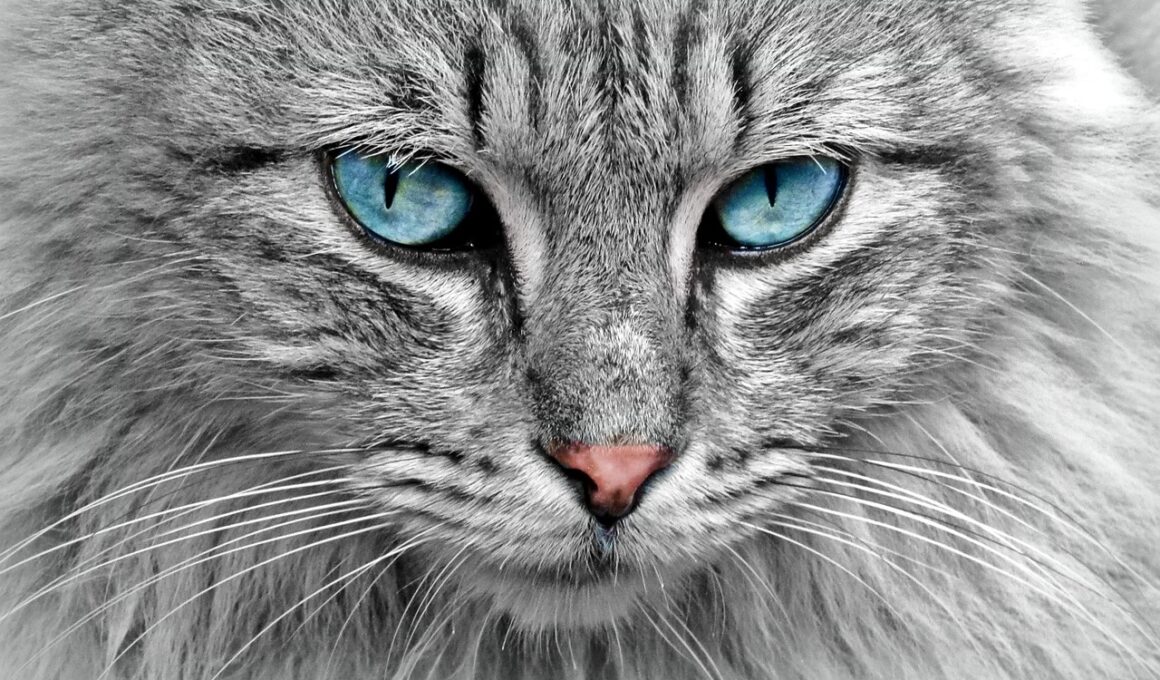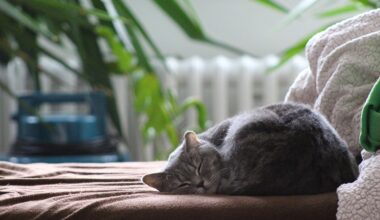Understanding Cat Behavior During Shows: A Comprehensive Guide
Watching cats perform at shows can be a delightful experience for enthusiasts and owners alike. The behavior of cats during these events can vary significantly based on their personalities, training, and comfort levels. Understanding these behaviors is critical for both judges and spectators. Many cat owners often prepare their feline friends for this kind of environment, exposing them to various stimuli, such as loud sounds and crowds. This exposure can significantly impact how a cat behaves during showing events. Cats may exhibit a range of emotions, including curiosity, anxiety, or fear, depending on the surroundings. Some cats become overly energetic, while others may remain withdrawn amidst the excitement. It’s essential to acknowledge and adapt to these behavioral signs to ensure a positive experience for the feline participant. Observing a cat’s body language can provide insights into their state of mind; a relaxed posture often indicates comfort, while puffed fur may signal distress. Consequently, building a rapport with the feline before and during shows can enhance their performance and well-being significantly.
Preparation is key to ensuring a cat behaves well during a show. Before the actual event, it’s prudent to create a comprehensive training plan. This can involve various factors such as socialization, acclimatization, and even grooming practices. Socialization is vital; introducing your cat to different environments, people, and other animals helps minimize stress. Taking your cat to smaller events can ease them into the atmosphere of a larger cat show. With regards to acclimatization, let your cat explore the show venue a day prior, allowing them to get used to unfamiliar sights and sounds. Proper grooming practices shouldn’t be overlooked either. Regular brushing, nail trimming, and bathing prior to the show can ensure that your cat looks its best and feels comfortable. Include healthy treats during training sessions to encourage positive behavior and make the experience enjoyable for the cat. An important aspect to remember is maintaining a consistent routine both at home and during the show. This helps reassure your cat amidst the changes in environment.
Recognizing Stress Signals in Cats
Understanding how to recognize stress signals in your feline is crucial during shows. Cats may exhibit body language that indicates discomfort or anxiety. Common signs include dilated pupils, flattened ears, or a tucked tail. If a cat appears to be hiding or avoiding eye contact, these are also potential indicators of distress. In these instances, it’s wise to take a step back and reassess the situation. Offering a familiar toy or blanket can provide comfort in stressful scenarios. It’s essential to create a safe space where your cat can retreat if needed, providing them calmness and security. Additionally, allow for breaks in-between show segments, allowing the cats to decompress. This not only helps manage stress but can improve overall performance during showing. Practicing handling techniques can also prepare a cat for unexpected situations. For instance, introducing the cat to various judging styles can reduce surprises. Familiarity with the judges can also help in easing any anxiety the cat may feel during evaluations. All these behaviors are part of ensuring a healthier, enjoyable show experience.
Each cat possesses a unique personality, which plays a significant role in its behavior during shows. Some cats thrive in the spotlight, showing off their personalities with confidence, while others may display timidness or apprehension. Factors contributing to a cat’s demeanor include genetics, past experiences, and environmental variables. One key aspect of a well-socialized cat is its ability to adapt to changing surroundings and various situations. Owners need to observe their own cat’s tendencies, as understanding them can aid in preparation for a show. Some breeds naturally possess a more outgoing demeanor; for instance, Abyssinians or Bengals may enjoy interaction with crowds. Conversely, breeds like the Persian might prefer more tranquility. Thus, identifying your cat’s behavior patterns can assist in strategizing your approach at shows. Owners can leverage their cats’ strengths by creating positive scenarios, encouraging interaction through treats or playful engagement. This not only enhances the showing experience but also fosters a stronger bond between the owner and the cat. Connecting with your pet on a deeper level can yield potential benefits when exposing them to the competitive show circuit.
Behavioral Reinforcements
Positive reinforcement is highly effective when training a cat for shows. Conditioning a cat using rewards can improve its confidence and encourage desired behaviors. Successfully navigating the show environment may take time and patience; therefore, creating positive experiences is vital. Use high-value treats or praise when your cat displays desired behaviors during practice sessions. For example, rewarding a cat for standing still or responding to its name can reinforce good behavior in similar settings during the show. It’s also imperative to maintain consistency within the reinforcement system. Doing so ensures the cat becomes accustomed to expectations. Avoid yellling or harsh reprimands; such actions can exacerbate fear or anxiety. Instead, focusing on the rewards leads to a more positive training atmosphere. Owners should also celebrate small victories, acknowledging every step taken toward improvement. Gradually introducing new stimuli during training sessions can also acclimate the cat to the show environment. Different textures, sounds, and interactions create a basis for adaptability. This slower integration can do wonders for a cat’s confidence when it is eventually showcased in a competitive environment.
Another crucial aspect to consider is how the show official judges your cat’s performance, as their interactions can influence the cat’s behavior. Each judge has an individualized approach, potentially causing different reactions in participating cats. Understanding these techniques can aid owners in preparing their felines. Some judges may be more approachable, speaking softly to the cats, while others may exhibit a more authoritative demeanor. It’s vital for a cat to be comfortable with the judge’s assessment style. Owners can mimic various judging approaches when training, allowing for better adaptability during the actual event. This method allows the cat to become acquainted with different handling techniques and personalities. Encouragement during such evaluations can help dispel fears, fostering a positive experience. Moreover, it’s important to understand that the evaluation is not solely about the cat’s appearance or performance. Recognizing how your cat responds to various judge styles can shape your strategy at the show. Creating opportunities for your cat to shine, while remaining aware of its temperament, will lead to an engaging experience for both the cat and its owner.
Post-Show Evaluation and Reflection
After the show, evaluating your cat’s performance becomes essential for preparing for future events. Taking notes about your observations can provide valuable insights. Reflect on your cat’s behavior, moments of confidence, and any signs of stress displayed throughout the event. This reflection will help identify areas for improvement or adjustments in training. Did your cat respond well to crowd noises or exhibit hesitation? Such reflections can help owners adapt their training approaches and strategies accordingly. Additionally, discussing insights with fellow cat owners or trainers can provide a broader perspective on handling similar situations. Networking with others in the cat show community can create a support system, facilitating shared experiences and tips. Most importantly, make an effort to celebrate the effort your cat displayed during the show. Regardless of the outcome, recognize their hard work and dedication. Providing comfort after the show, such as a cozy spot or favorite treats, can help wash away any after-show anxiety. The combined experiences will not only refine behavior for future shows but strengthen the bond between the owner and their feline partner.
In summary, navigating cat behavior during shows involves understanding, preparation, and active engagement. Each element contributes to shaping a delightful experience for both cats and their owners. Recognizing behavior patterns and stress signals allows for a more tailored experience. Training that emphasizes positive reinforcement can lead to confident felines willing to showcase their personalities. Owners must remain responsive to the unique needs of their cats, adjusting behaviors to foster an environment conducive to success. Familiarizing cats with show environments and maintaining routines can help alleviate stress. Furthermore, reflective evaluations after shows guide owners on what approaches worked well. Engaging with the broader cat show community also encourages continuous improvement. Ultimately, the goal is to ensure the overall well-being and happiness of the feline during shows. Striking a balance between performance and comfort is essential, creating opportunities for cats to shine without causing distress. By implementing these strategies, owners are likely to cultivate a positive atmosphere, leading to better performances and loving connections with their cats. The journey may be challenging; however, ensuring that each participant is cared for will result in a rewarding experience for everyone involved.


